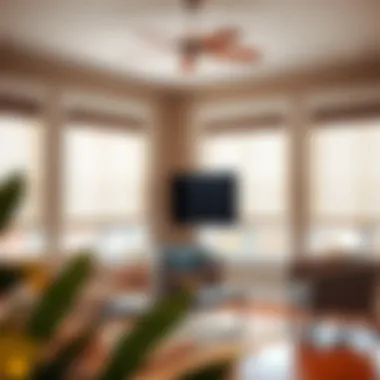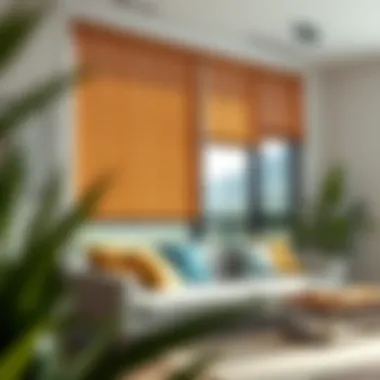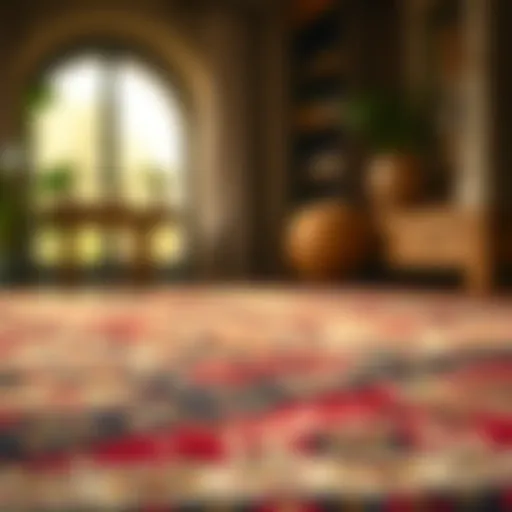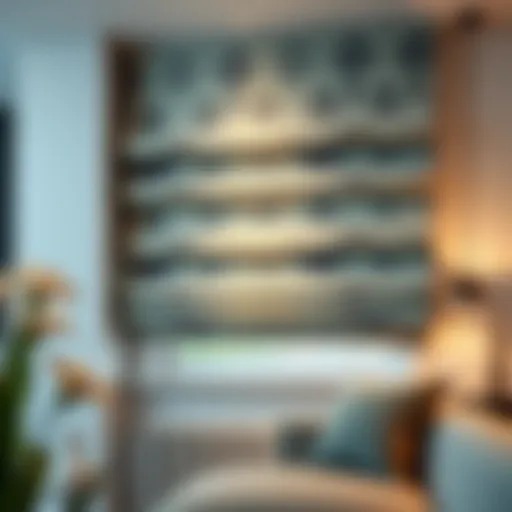Smart and Stylish Budget Blinds Solutions for Your Home


Intro
Blinds can be the unsung heroes of home decor. They shield us from the unrelenting sun, offer privacy, and can even enhance the aesthetics of a room. Yet, many homeowners shy away from upgrading their window treatments due to cost concerns. The good news is that stylish, functional blinds don’t have to break the bank. This guide aims to illuminate budget-friendly blind solutions that will add both flair and practicality to your living spaces.
Navigating the world of window treatments can be a bit like walking through a jungle—overwhelming and intricate. With so many choices out there, it's crucial to discern the right fit for your home without going over budget. Not only do we need to consider style, but also the functionality and maintenance of blinds. This article will walk you through a range of materials, styles, and installation tips that will allow you to maximize both value and visual appeal.
"Good design is in the details—especially when it comes to blinds. Every choice matters—colors, materials, and style all contribute to the overall atmosphere of your home."
Whether you are a homeowner looking to refresh your interiors, a designer seeking innovative ideas, or a DIY enthusiast ready to take on a project, this guide has something for you. Let’s delve into the first section, where we explore the trends in furniture styles that can harmoniously integrate with your chosen window treatments.
Understanding the Need for Budget Blinds
When it comes to home improvement, window treatments play a crucial role in defining the overall aesthetic and functionality of a space. Blinds, in particular, can radically alter the look of a room while also providing essential benefits such as light control and privacy. However, many homeowners shy away from upgrading their window treatments, fearing the cost. This is where budget blinds come into play, providing a decent balance between style and expenditure.
Defining Budget Blinds
Budget blinds refer to window treatment options that are designed to be economically friendly while still meeting basic functional and aesthetic requirements. These blinds come in various forms, such as roller, vertical, and mini blinds, made from both synthetic and natural materials. Often, they are crafted to mimic more expensive finishes, providing the aesthetic appeal of high-end products without breaking the bank.
Choosing budget blinds does not mean sacrificing quality; rather, it’s about understanding what materials bring the most bang for your buck and distinguishing between style preferences and practical needs. This knowledge will empower homeowners to select products that charm their interiors while working within a contained budget.
Why Opt for Budget-Friendly Options?
There are numerous merits to selecting budget-friendly blinds over high-end counterparts:
- Affordability: One of the primary reasons for opting for budget blinds is cost-effectiveness. They allow for significant savings, particularly if you need to cover multiple windows.
- Variety of Design Choices: Budget blinds come in various styles and colors, making it easy to find something that suits any room. Homeowners can refresh their space without spending a fortune.
- Ease of Maintenance: Many budget blinds are made from synthetic materials designed to be durable and easy to clean, making upkeep a pragmatic consideration for busy households.
- Accessibility: These blinds are typically readily available both online and in local stores, removing the hassle of an extensive search often needed for high-end products.
Moreover, with budget blinds, there’s an inherent flexibility. If trends shift or you decide to redecorate, it won’t feel like money wasted when it’s time to swap them out. This approach gets rid of the fear associated with making expensive window treatment investments. Instead, you can confidently experiment with different looks and setups.
“Budget blinds offer space to play with style without the weight of guilt over spending.”
As homeowners prioritize not just functionality, but also the aesthetic quality of their living spaces, understanding the landscape of budget blinds ensures they make informed decisions. Investing in affordable window treatments equips dwellers to enhance their environment while considering both economic limitations and personal tastes.
Assessing Your Window Treatment Requirements
Assessing your window treatment requirements forms the crux of choosing budget-friendly blinds. This process isn't just about picking something that looks good; it's about making decisions that will complement your living space, serve practical purposes, and fit within your financial parameters. Most importantly, understanding what you need allows you to make informed choices that keep your home both stylish and functional.
When you start assessing your needs, think of it as a journey. A journey that begins with the basics—measuring your windows effectively and comprehending how light and privacy needs impact the selection of blinds. Not every window is created equal, and neither should the blinds that cover them. A one-size-fits-all approach may lead to frustrating outcomes. So, below we break down two vital steps you need to take.
Measuring Your Windows Effectively
Measuring your windows may seem like a straightforward task, but there’s more to it than just tapping a tape measure against the frame. The dimensions of your windows have a significant influence on the type and style of blinds suitable for your space. An incorrect measurement can not only lead to wasted money but can also mess with the overall aesthetic of your rooms.
To measure effectively, consider the following steps:
- Gather Your Tools: A metal tape measure is the best choice. Paper or fabric measures can stretch and provide inaccurate figures.
- Measure Width First: For a snug fit, measure the width at the top, middle, and bottom of the window frame. Always note the smallest measurement to use as your standard.
- Measure Height Next: Again, take measurements from the left, middle, and right side, keeping the smallest measurement for accuracy.
- Consider Mounting Options: Decide if you prefer the blinds to mount inside the window frame (an inside mount) or outside (an outside mount). Each has implications for how you measure.
"Getting your measurements right the first time can save you a heap of headaches later on!"
Understanding Light and Privacy Needs
Light and privacy requirements are crucial aspects of selecting the right window treatment. Not all rooms need the same level of brightness or seclusion, and understanding these differences can shape your choice better than anything else.
First, evaluate the function of the room:
- Living Rooms: Here, you might want a balance of natural light and privacy. Blinds that can be adjusted easily, like Venetian or vertical blinds, are often suitable.
- Bedrooms: If you need a good night's sleep, blackout blinds may be more appropriate. They help ensure total darkness during the wee hours which is essential for restful sleep.
- Kitchens and Bathrooms: Areas that are often humid may benefit from materials that resist moisture. For privacy, consider top-down, bottom-up shades that allow light while still maintaining your privacy.
Understanding how light and privacy interplay in your space helps in making wiser decisions while shopping for budget blinds. Each choice should speak to the environment you’re creating, giving serious thought to not just what you want, but what you need. By assessing these two key areas, the chances of ending up with a neglected space dwindle significantly.
Exploring Material Options


When embarking on the journey to find the perfect budget-friendly blinds, the choice of material stands out as a fundamental decision that can shape both aesthetics and functionality. Different materials bring distinct characteristics to the table, influencing not just the look but also the longevity and practicality of your window treatments. Understanding the nuances of various materials will empower homeowners and designers alike to make informed choices that fit their specific needs and budgets.
Fabric Blinds: Versatility and Options
Fabric blinds offer a delightful array of styles and colors that can accentuate any room's ambiance. These blinds are particularly popular for their softness and warmth, capable of creating a cozy environment. They can be found in sheer, semi-sheer, and blackout options, allowing for flexible light control.
- Design Potential: With a variety of textures and patterns available, fabric blinds can be beautifully tailored to reflect personal taste. Think floral prints for a cottage vibe or sleek, solid colors for a modern touch.
- Energy Efficiency: Certain fabric types also provide insulation, which can help manage heating and cooling costs.
However, it’s crucial to consider their maintenance needs, as fabric blinds may require regular cleaning to avoid dust accumulation and fading from sunlight.
Vinyl and Faux Wood: Budget Durability
For those seeking a robust alternative, vinyl and faux wood blinds stand out as exemplary options. They mimic the elegance of traditional wood but often come at a fraction of the cost.
- Water-Resistant Qualities: Unlike real wood, vinyl and faux wood are impervious to moisture, making them ideal for rooms like kitchens and bathrooms where humidity is prevalent.
- Ease of Maintenance: These materials are effortless to clean—just a quick wipe with a damp cloth typically does the trick. This convenience is invaluable for busy households.
While they may have a more synthetic feel compared to organic materials, the affordability and longevity make them a sensible choice for budget-conscious shoppers.
Natural Materials: Cost-Effective Choices
Natural materials, such as bamboo or woven grass, can impart an eco-friendly touch to your home. These options are not only sustainable but also add a unique texture and aesthetic that artificial materials often can't replicate.
- Biodegradable: Opting for blinds made from sustainable sources reduces environmental impact, aligning with growing green living trends.
- Natural Beauty: Their earthy tones can seamlessly blend with a variety of decors, providing warmth and character.
However, it’s important to remember that natural materials may vary in pricing depending on the source and craftsmanship, so diligent research can uncover cost-effective options without sacrificing quality.
"Choosing the right material for your blinds is essential, as it impacts both the style and functionality of your space."
Evaluating Styles and Types of Blinds
When it comes to window treatments, choosing the right blinds is a significant move that shapes both the look and practicality of your space. Evaluating the various styles and types of blinds available isn't just about aesthetics; it's deeply intertwined with functionality. This section examines the reasoning behind selecting specific styles, considering factors such as materials, light control, and room size. Choosing the right blinds can enhance privacy, improve light management, and boost your home's overall vibe without breaking the bank.
Roller Blinds: Minimalist Yet Functional
Roller blinds stand out for their sleek and uncomplicated design. They're a go-to choice for spaces needing style without clutter. Made from a single piece of fabric, these blinds roll up or down with ease, providing a clean look that complements any decor style, from ultra-modern to classic.
The versatility of roller blinds is particularly appealing. You can find them in an array of colors and patterns, giving you the freedom to match any room's theme. For instance, consider a vibrant print in a playroom or a soothing neutral palette in a bedroom. Beyond appearances, roller blinds are easy to maintain; most fabrics are washable and resist fading, making them a long-term investment.
Key Features of Roller Blinds:
- Space-efficient: Ideal for smaller areas
- Variety of fabrics: From sheer to blackout
- Easy to clean: Low maintenance option
Vertical Blinds: Ideal for Large Windows
If your home boasts large windows or sliding glass doors, vertical blinds might be your best friend. They’re particularly useful for controlling light due to their adjustable slats. You can tilt them to filter sunlight without completely blocking the view, ensuring you maintain a bright yet private atmosphere.
Besides their practical side, vertical blinds come in various materials like fabric, vinyl, or even aluminum. This variety allows you to either dress them up or down, depending on your room’s aesthetic. They can also help keep large spaces feeling cozy without sacrificing a refined look. With the right choice, vertical blinds can accentuate the height of your windows and add a touch of sophistication to your interiors.
Roman Blinds: A Touch of Elegance
For those looking to infuse a bit of elegance into their spaces, roman blinds are an excellent choice. Their fabric folds create a tailored appearance that adds warmth and sophistication to any room. When pulled up, they gather neatly at the top, making a chic statement while letting in ample light.
What makes roman blinds particularly appealing is their suitability for a variety of fabric choices—think sumptuous velvets or breezy linens. They can effortlessly elevate the ambiance of a living room or bedroom, providing a layer of comfort. Plus, they’re versatile; many homeowners appreciate how they can enhance traditional decor while still fitting into contemporary settings.
Mini Blinds: Compact and Practical
Mini blinds serve a purpose that is both practical and efficient, particularly in tight spaces. These horizontal slats, typically made of aluminum or vinyl, are compact yet offer robust control over light and privacy. They can easily fit into smaller windows, making them an excellent choice for kitchens or bathrooms.
What sets mini blinds apart is their convenience. They can be adjusted to allow just the right amount of light while preventing prying eyes from peeking in. With a variety of color finishes available, mini blinds can also serve a decorative function, providing an understated elegance that doesn't overpower a room.


DIY Approach to Budget Blinds
Taking a hands-on approach to selecting and installing budget blinds can transform your space while keeping costs in check. A DIY approach allows for both creativity and functionality, making it an appealing option for homeowners and decor enthusiasts alike. One of the major benefits of going the DIY route is customization. You can choose materials, colors, and styles that resonate with your personal taste, making your home feel uniquely yours.
Moreover, the feeling of achievement when completing a project yourself can be quite gratifying. It often fosters a deeper connection to your home, knowing that you’ve tailored your environment with your own two hands. Not only does it save you money, but it also gives you the freedom to innovate and experiment.
However, it's important to recognize that DIY demands careful planning and consideration. Factors like your skill level, time availability, and tools are crucial to ensuring that your blinds not only look good but also function properly. Taking this into account makes for a smoother, more enjoyable experience overall.
Creating Custom Blinds
When it comes to custom blinds, the sky's the limit. You have the power to create solutions specifically tailored to fit your windows, needs, and aesthetic. Imagine choosing fabric colors that complement your existing décor or selecting a style that suits your practical requirements. For instance, if you have wide windows that tend to let in too much sunlight, you might consider custom roller blinds made from light-filtering fabric to maintain ambiance while offering light control.
To get started, you'll need some measurements and materials. Measuring your windows precisely is key. Here’s a breakdown of what you might need:
- Materials: Fabric, wood, faux wood, or vinyl
- Tools: Measuring tape, scissors, sewing machine (for fabric options), adhesive, or screws
- Optional Accessories: Decorative cords, tassels, or clips to personalize your creation
Once you have your materials lined up, think about how you’d like to construct them. For example, you could opt for a simple rod pocket design for fabric blinds or a flat panel for a more modern look. It’s also worth considering combining materials or styles for a fresh twist that stands apart from typical store-bought options.
Installation Tips for DIY Enthusiasts
Installing your own blinds can feel daunting, but with a bit of organization and following a few basic principles, you can make it a breeze. Here are some tried-and-true tips to ensure your installation is smooth:
- Gather Your Tools: You’ll likely need a drill, a level, measuring tape, screws, and brackets. Having everything on hand can save time and prevent frustration.
- Read Instructions Thoroughly: If you’re following a specific design or tutorial, take time to understand all the steps before diving in.
- Level is Key: Use a level to ensure that your blinds hang straight. A crooked installation can be quite noticeable and detracts from the overall look.
- Securely Attach Brackets: Make sure to anchor the brackets properly into the wall or window frame. If you’re worried about keeping it sturdy, consider using wall anchors for added support.
- Double Check Measurements: Before making any cuts, always double-check to ensure you’ve got the right dimensions. Measure twice, cut once – a good rule to live by!
These tips aren't just for the novice; even seasoned DIYers can benefit from a checklist to maintain clarity during the installation process. A well-installed set of blinds can elevate a room dramatically, enhancing both privacy and style.
By taking a DIY approach to budget blinds, you can create stunning window treatments tailored to your taste without breaking the bank. Each project is an opportunity to express personal style while being frugal.
Purchasing Budget Blinds
Budget blinds can really offer a surprising blend of style and practicality, and getting them can save a pretty penny while still allowin’ you to dress up your space. What’s more important than a few dollars saved? Not much, especially in a world where those small savings can add up to a nice sum over time. In this section, we’ll talk about factors you should think about when you’re ready to make that purchase. From pricing to sourcing these window treatments, we’ll cover it all.
Where to Buy Budget Blinds
When it comes to where to buy your budget blinds, the options can feel as wide as a barn door. You’ve got local stores like Home Depot or Lowe's where you can check out various styles in person. There’s something about eyeballin’ the colors and textures that can really help you make up your mind.
However, if you're all about convenience, online retailers like Amazon or Wayfair have got your back. Many offer great deals, and their range can be mind-boggling. You can flick through reviews and pricing right from your couch.
But don’t stop there! Local shops sometimes offer unique styles that you just can’t find online. And let’s face it, supporting your local businesses keeps your neighborhood vibrant. Here’s a quick list of potential places:
- Home Improvement Stores (like Home Depot, Lowe's)
- Department Stores (think Target or Walmart)
- Specialty Home Decor Stores
- Online Retailers (like Amazon, Wayfair, or Overstock)
Understanding Pricing and Quality
Understanding how pricing works in the blinds world is crucial. Often, you get what you pay for. That’s not to say that budget options are all bad, but it’s important to be aware of what you’re potentially sacrificing for a lower price. Look for materials that balance quality and cost. For instance, vinyl or faux wood blinds tend to be more affordable yet surprisingly durable.
When you’re browsing, take a moment to assess:
- Material Quality: Check if it feels sturdy or flimsy. Don’t let an enticing price tag fool ya.
- Warranty Details: A good warranty can be a sign that a manufacturer stands behind their product.
- Customer Reviews: If past buyers are happy, chances are you will be too. Nothing beats a bit of word of mouth.
Also, remember that sometimes it’s worth spendin’ a little more for longevity. A cheap pair of blinds that need replacing in six months might cost you more in the long run.
"Quality may cost a little more at first, but it usually pays for itself in the end."
In the end, it’s all about finding that sweet spot between cost and quality. Make your money work without compromising style. Happy blinds hunting!
Maintenance and Care for Blinds
When it comes to maintaining a fresh look and prolonging the lifespan of your blinds, it’s all about the details. Regular maintenance and care for your blinds not only keep your home looking sharp but also ensure that your investment in budget-friendly window treatments truly pays off. After all, no one wants to spend time and money on something that looks worn out within a year or two. By putting in a little effort to care for your blinds, you can save yourself the hassle and cost of replacements down the line.


One of the obvious advantages of well-maintained blinds is the enhancement of their functionality. For example, dirty or damaged blinds might not open and close properly, impacting how much light enters your space. Conversely, properly maintained blinds can help with energy efficiency by effectively blocking sunlight or insulating your windows during colder months. Caring for them also plays a pivotal role in preventing wear and tear that could lead to costly repairs over time.
A systematic approach to cleaning and upkeep can benefit various materials used in blinds—from fabric to vinyl—and can greatly improve the aesthetics of your home. No need to be overwhelmed; with some basic techniques in your toolbox, you’ll find that even budget blinds can shine like a million bucks.
Cleaning Techniques for Different Materials
Each type of blind has its own cleaning methods geared towards keeping them in prime condition. For instance, fabric blinds are usually more delicate and require gentle care. Here’s a breakdown:
- Fabric Blinds:
- Vinyl or Faux Wood Blinds:
- Real Wood Blinds:
- Dust Regularly: Use a microfiber cloth or a feather duster to keep them free from loose dust. It’s best to do this every week or so.
- Spot Clean Stains: For any spills or marks, use a lightly dampened cloth with a mild detergent. Gently dab, don’t rub!
- Deep Cleaning: Occasionally, you might want to consider professional cleaning services or follow the manufacturer’s guidelines for washing, but make sure to check labels for any specific instructions.
- Wipe Down: A damp cloth with a bit of dish soap works wonders. Just make sure they are completely dry afterwards, as moisture can warp the material.
- Use a Vacuum: Attach a brush tool and vacuum over the blinds to remove dust without scratching their surface.
- Dust Weekly: Just like with vinyl, a microfiber cloth is your best friend. Dusting helps avoid buildup of dirt.
- Wood Cleaner: Use a cleaner designed for wood finishes to maintain shine and prevent damage. Avoid excessive moisture, as it can harm wood.
The key here is consistency, which goes a long way in preserving your blinds.
Repairing Common Issues
Over time, even the best of blinds can encounter a few hiccups. Whether it’s a missing slat or a tangled cord, knowing how to tackle minor issues can save you from unnecessary frustration. Here are common problems you might face and how to address them:
- Slats That Won't Rotate: Sometimes, the mechanism can get gummed up with dust or debris. Try gently cleaning the track or using a lubricant that’s safe for the specific material.
- Broken Cords: If the pull cord is frayed or snaps, you may be able to replace just that part without needing an entirely new set of blinds. Check with your manufacturer about compatible replacement pieces.
- Warpage in Wood Blinds: Changes in humidity can cause real wood blinds to warp. If this happens, try adjusting how they hang by slightly loosening the mounting brackets to allow for a natural curve back.
"An ounce of prevention is worth a pound of cure." - Benjamin Franklin
Enhancing Aesthetics with Accessories
The aesthetic appeal of a room can often hinge on the choices made in window treatments. Beyond just functional aspects like privacy and light control, the accessories that accompany blinds can significantly elevate a space's overall design. Accessories serve not just to complement the blinds but also to create a cohesive look that ties the whole room together. When well-considered, they can add layers of depth and richness, transforming plain windows into striking focal points.
A well-dressed window can help in crafting an atmosphere that reflects personal style. When it comes to budget-friendly blinds solutions, blending affordability with effective design strategies through accessories can make a world of difference. Let’s dive deeper into specific elements that can enhance the aesthetics of your blinds.
"A simple change in accessories can shift the whole vibe of a room, turning the mundane into an absolute spectacle."
Complementary Accessories for Blinds
Adding complementary accessories to blinds includes using items like decorative holdbacks, tassels, or valances, all of which can add a level of sophistication without breaking the bank.
- Holdbacks: These are used to hold curtains or blinds tied back from the window. They can be found in simple metallic finishes or more ornate designs that elevate the appeal of your functional window treatments.
- Tassels: Adding decorative tassels to the cords of blinds can provide a touch of elegance and whimsy. They come in various styles, allowing for a touch of personality and fun, ensuring they blend well with the decor.
- Valances: These sit atop the blinds and can either be functional or purely decorative. They can change the perception of height in a room and also serve to hide the headrail of the blinds if aesthetics are the primary concern.
Choosing the right accessories is vital. It is essential to consider the existing decor in the room and select items that enhance rather than clutter the space. Thoughtfully chosen accessories will draw the eye and accentuate the beauty of your blinds while providing a polished finish.
Layering for Style and Function
Layering is another powerful design strategy that enhances the visuals of window treatments. By mixing various types of blinds or combining them with curtains, one can achieve both style and function in an affordable manner.
- Visual Interest: Combining sheer curtains with solid blinds not only creates depth but also offers versatility in controlling light and privacy. Different textures and opacity levels can yield intriguing visual contrasts, making the window area a dynamic element of the overall room.
- Functional Benefits: Besides the aesthetic appeal, layering window treatments can also improve energy efficiency. For example, pairing thermal curtains with blinds can help retain warmth in the colder months while providing a chic look at the same time.
- Customization: Layering allows for a tailored approach to window treatments. Homeowners can customize their approach based on their unique needs—whether it's a cozy atmosphere or a sleek modern feel, layers can easily adapt to any style.
Finale: Blinds That Fit Your Budget and Lifestyle
The conclusion serves as a way to encapsulate the journey through the intricacies of selecting budget blinds without sacrificing style or practicality. It shines a light on the importance of making informed decisions when choosing window treatments that align with both personal aesthetics and functional requirements.
Budget blinds have evolved significantly, with many options providing not just cost savings but also enhancing the overall ambiance of your living space. By understanding the various materials, styles, and installation methods available, homeowners can strike a balance between elegance and efficiency. It’s evident that a limited budget need not translate to compromised quality or visual appeal.
Ultimately, blinds are not just about covering windows; they are about creating an environment that reflects your personality while meeting your daily needs.
Key Considerations
- Personal Style: Window treatments are a reflection of personal taste and can significantly alter the aesthetics of any room. Budget blinds come in a range of designs, suitable for various decor themes, from ultra-modern to rustic.
- Functionality: Choosing the right type, such as roller, vertical, or mini blinds, ensures you meet your privacy and light control needs effectively. For instance, vertical blinds work well in large spaces, while mini blinds can fit snugly in tight spots without looking overcrowded.
- Quality vs. Price: It’s crucial to differentiate between low-cost options and budget-friendly quality. A prudent buyer should consider not only the price but the materials used and the warranty provided. Many budget blinds are manufactured from durable materials that withstand the test of time, avoiding additional replacements.
Benefits of Budget Blinds
- Cost-efficacy: Allows homeowners to redeploy funds to other home improvement projects while still enhancing their environment.
- Wide Variety: Significant options available in the marketplace, suiting various decors and preferences.
- Accessibility: With many online and local retailers and DIY solutions, finding budget blinds that meet your needs is simpler than ever.
Final Thoughts
In this ever-changing market, the emphasis on maximizing both style and function persists. Homeowners need to prioritize informed selections that enhance their lifestyles while keeping budgets intact. Whether you are hosting a dinner party or enjoying a quiet evening, your choice in window treatments plays a pivotal role in setting the right mood. Budget blinds serve as a perfect solution, ensuring no corner of your home feels left out. Modern living can be stylish and affordable, making it a perfect blend for those who know where to look and how to optimize time and resources.















